19+ Landing Page Statistics For 2024: All You Need To Know
Keen to keep your finger on the pulse when it comes to your landing page strategy?
Well, you’ve come to the right place.
In this article, we’ll be covering the key landing page statistics relating to landing page conversion, creation, and testing to help you to improve your landing page strategy in order to boost leads and conversions.
Let’s start by looking at some key landing page conversion and lead generation statistics.
Editor’s picks
- The average conversion rate of a landing page is 26%. (Databox)
- Landing pages with a 0-2 second load time have the highest conversion rates. (Portent)
- Almost 30 % of landing pages have too much copy. (Unbounce)
Landing page conversion and lead generation statistics
Landing pages are all about conversions, so it’s important to optimize your pages to achieve the highest conversion and lead generation rates possible. These stats should offer some insights into optimizing landing pages for conversion and lead gen this year.
The average conversion rate of a landing page is 26%
This is according to a study carried out by Databox in 2019. Conversion rates can vary massively depending on the industry, but this average represents a ballpark figure of a “good” conversion rate. However, almost 10% of businesses reported having exceeded this figure by quite a margin, with conversion rates of 70%+.
Source: Databox
Most landing pages have a conversion rate of 10% or less
Despite the overall average conversion rate for landing pages standing at 26%, most landing pages have a conversion rate of 10% or less, which for some businesses is more than sufficient to make using landing pages a sustainable strategy.
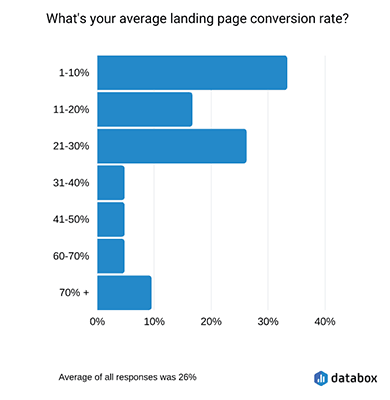
This highlights an opportunity for those in the conversion rate optimization space to assist businesses with their landing pages. Or for businesses to invest in hiring for dedicated conversion related roles.
If you need help in this area, check out our article on landing page best practices to get a head start. General rule of thumb is to optimize your pages based on best practices, then run A/B split tests to further improve conversions.
Landing pages that ask for personal information like name and gender have the worst conversion rates
According to a study carried out by Omnisend, landing pages that included sign-up forms had less conversion power when they required people to divulge their birth date or gender. Forms including these fields had 5-6% conversion rates. The best-performing sign-up forms included only email and phone number fields and had a 10.15% conversion rate.
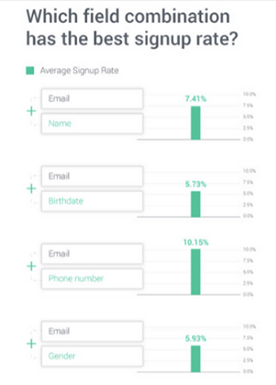
Landing pages with a 0-2 second load time have the highest conversion rates
It goes without saying that the faster a site loads, the better, but this is especially true for landing pages. According to a Portent study landing pages with a 0-2 second load speed converted significantly better with those with a longer load speed.
The takeaway — modern consumers aren’t willing to wait for slow sites to load.
Source: Portent
In the first 5 seconds after a click, each additional second of load time reduces a websites conversion rate by 4.42% on average
If your landing page isn’t meeting the ideal 0-2 second load time, it’s still important to aim to achieve the fastest speeds you can. Each second that passes whilst a user are waiting for a page to load, conversion rates drop by a whopping 4.42%.
So although the difference between a 3 and 4-second load speed doesn’t seem that great, it can have a huge impact on your conversions.
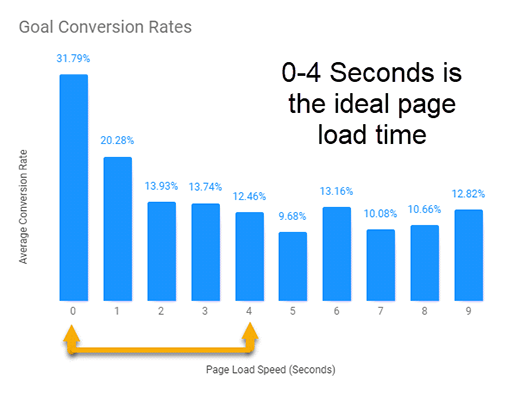
Having 10-12 landing pages increases leads by up to 55%
Hubspot’s study also showed that the lead generation and conversion power of sites increase the more landing pages they had.
The takeaway from this statistic is clear. The more landing pages you have, the better. Having a range of landing pages will allow you to segment your traffic sources and tailor specific landing pages to different segments of your audience. In addition to this, it will give people more opportunities to land on your page in general.
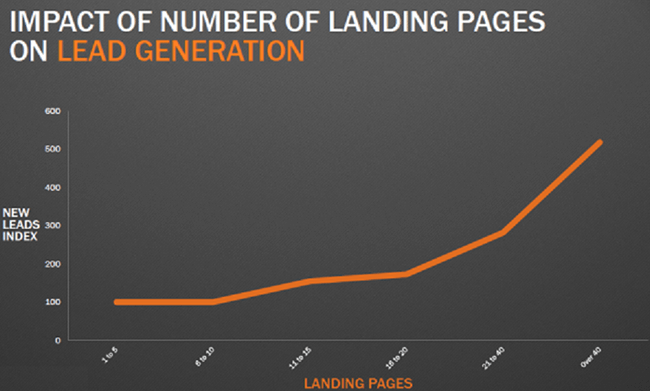
Want more lead generation statistics? Check out our dedicated article on lead generation, facts, trends, and stats.
Landing page creation statistics
Creating a high converting landing page is a fine art, and it takes a keen eye and a lot of testing to get the balance just right. These statistics should give you an idea of what to include (and what not to include) when creating landing pages for your business.
Almost 30 % of landing pages have too much copy
According to Unbounce, 29.5% of landing pages contain too much copy. The study showed that business sector landing pages with fewer than 100 words converted 50% better than those with 500 words or more.
What can we learn from this? Concise and straightforward copy is more effective than reams of complicated text.
Source: Unbounce
Pages with only 1 CTA have 1.6% more conversion power than those with 2 or more
The study from Unbounce showed that pages with one clear call-to-action (or link) converted 13.5%, whereas pages with 2-4 links or CTA’s only converted 11.9% of visitors. This statistic shows that it really pays to guide your customers towards one specific call-to-action.
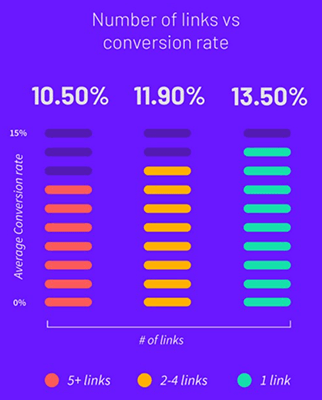
Most landing pages include 5 form fields on average
Databox found that most landing pages that featured lead capture forms included 5 or more fields in the form.
Despite this being the norm, marketing experts like Alexandra Zelenko of DDI Development believe that limiting form fields is more beneficial for conversions. She believes “the less information you ask for, the higher your conversion rate will be.”
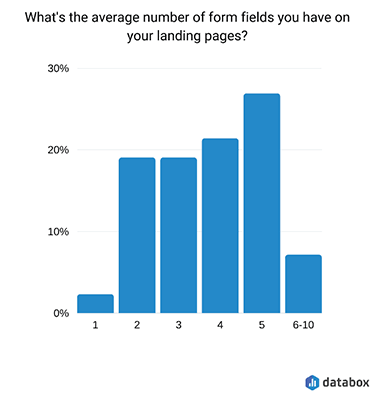
Featuring more than one offer on a landing page can decrease conversion rates by as much as 266%
Just like with CTA’s, featuring too many offers on one landing page can decrease your conversion rates significantly. This statistic shows that it’s a good idea to have landing pages guiding people towards one specific offer if you want to achieve the highest conversion rates possible.
Source: Wishpond
Landing pages that feature social proof convert 1.1% better than those that don’t
Social proof is a powerful thing. As this statistic shows, having photos of customers and social media posts boosts customer trust in your brand, products, or services and makes them more likely to take action.
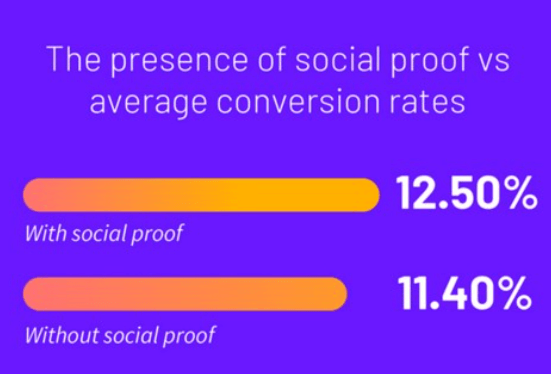
36% of top landing pages feature testimonials
A similar study from Nifty showed that testimonials were a good way to utilize social proof in landing page creation. The study found that 36% of the top converting landing pages included testimonials from customers or clients.
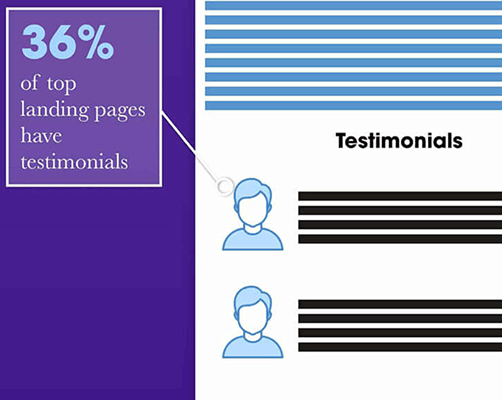
Two-step landing page forms have been shown to be 30% more effective than the traditional 1-step form
Murray Datis Mohsenipour from Outback Team Building & Training shared some of his insights with Databox.
According to his findings, using a two-step breadcrumb style form to collect customer information was 30% more effective than using a traditional 1-step form. The idea behind this is that you can gather more information without overwhelming users with a long form with 5+ fields.
Source: Databox
Featuring video content on landing pages can increase conversion rates by as much as 86%
Including video content on your landing page is a great alternative to overwhelming your customers with too much text. Videos make it easy to get your message across, and they have a great effect on conversion rates.
Source: Smart Insights
Including your business phone number on your landing page helps to boost trust and conversions
Building trust with your audience is really important, and studies have proven that including your business phone number on your landing page is a good way to do this.
The company that tested the method saw a 54% sign-up rate on a page that included a business phone number and only a 46% sign-up rate on a landing page that didn’t.
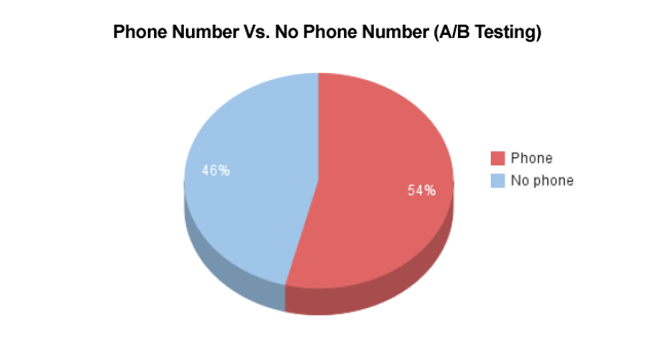
Landing page testing statistics
Once your landing pages are live, it’s important to test your pages and analyze the results in order to maximize their effectiveness. The statistics below offer some insight into landing page testing methods.
More than 20% of companies that use landing pages admit to not having a reliable testing method
If you want to achieve the highest conversion rates possible for your landing pages then testing is really important. It helps you to determine what works and what you need to change.
Unfortunately, many businesses find it hard to carry out reliable tests, so it’s worth dedicating some time and some of your budgets to figuring out your testing methods.
Source: Business2Community
A/B testing is one of the most popular ways to test landing pages, with 60% of businesses deeming this method “highly valuable”
This comes as no surprise as A/B testing or split testing is a great method to use when testing landing pages. It will help you to determine what factors drive conversions and what elements of your landing page have no effect whatsoever.
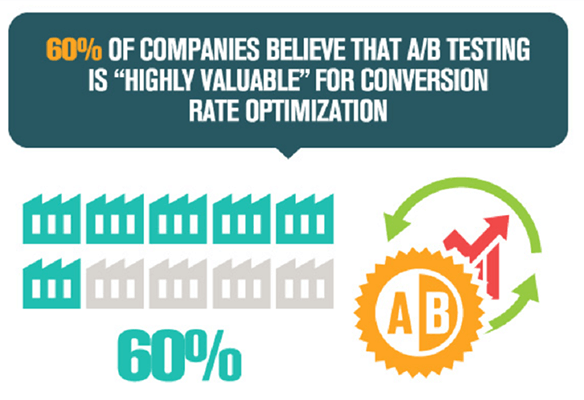
Good testing and targeting can help to increase conversions by as much as 300%
Testing is essential to optimizing your landing pages. Analyzing your test results properly and targeting specific segments of your audience or improving elements of your landing pages can have a huge effect on your conversion rates.
Source: SteelHouse.com
More than half of all companies perform fewer than 5 landing page tests per month
This statistic makes it clear that many companies are dropping the ball when it comes to landing page testing. The truth is, the more testing you can do, the better your conversion rates will be. Companies like Google, for example, have been known to run over 7000 tests on one page simply to check which copy was more effective.
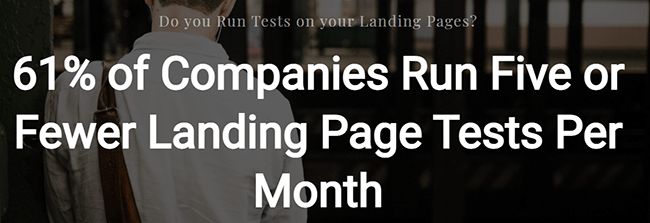
Final thoughts
Don’t fall behind, and neglect your landing pages. By just looking at these landing page statistics we have a better understanding of what we can do to improve our landing pages to maximize conversions, and ensure our businesses are successful.
Finally, it’s worth mentioning that landing page optimization is a critical factor that many businesses are lacking. If you need help with this, check out our best practices guide and our comparison of landing page software.
You may find these related articles useful:
